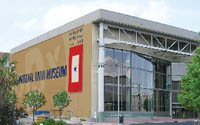With its latest expansion, the National World War II Museum plans to tell the whole story of the war
 The National D-Day Museum opened in New Orleans in 2000 and immediately became a prime tourist destination. As conceived by historians Dr. Stephen Ambrose and Gordon “Nick” Mueller, its current president, the museum dealt with the amphibious invasions of World War II. In 2003 Congress named it America’s National World War II Museum, and its focus broadened to include other aspects of the war. Now, with a major expansion in the works, it’s about to widen its focus even more.
The National D-Day Museum opened in New Orleans in 2000 and immediately became a prime tourist destination. As conceived by historians Dr. Stephen Ambrose and Gordon “Nick” Mueller, its current president, the museum dealt with the amphibious invasions of World War II. In 2003 Congress named it America’s National World War II Museum, and its focus broadened to include other aspects of the war. Now, with a major expansion in the works, it’s about to widen its focus even more.
Recently, New Orleans Living talked with Clem Goldberger, associate vice president of marketing, about the museum’s history, current exhibition and future plans. On the eve of Father’s Day, Goldberger also recalled the special meaning the museum had for her father, a World War II veteran.
“Long before I had any idea that I might work here, I brought my dad here,” she said. “It turned out to be about six months before he died. I’m so thankful I had opportunity to experience it with him. It’s a bit of a cliché now, but it really was the greatest generation.”
NOL: Why is the museum based in New Orleans?
CG: It goes back to a boatbuilder named Andrew Jackson Higgins, a rough and tumble entrepreneur from Mobile who established [his] business in New Orleans, primarily for the offshore oil industry. His boats had a shallow draft and were maneuverable through the coasts and bayous. He adapted his design for use in the war. About 20,000 Higgins boats were built here in New Orleans, along with PT boats, rescue crafts and specialty crafts. Without [Higgins’] design, which allowed the boats to land on an open beach, the entire strategy for the war in Europe would have changed.
Tell me about the current exhibition, Real to Reel: Hollywood and WWII.
The exhibition focuses on how the war affected Hollywood and how Hollywood affected the war. We have a delightful reel of clips that includes propaganda films and training films and wonderful photographs [and posters], many of which have never been seen before. We have one of the early film cameras that was used to shoot documentaries; medals that were awarded to Sterling Hayden, Douglas Fairbanks and others; parts of uniforms from stars who went to war.
The museum’s expansion, which will be completed in 2014, sounds amazing. What will it entail?
It’s a multiyear $300 million expansion that will create a six-acre campus of museum pavilions [surrounding] a wonderful green parade ground. It will enable us to tell the entire story of World War II in a meaningful way, with a high degree of technology and interactivity that will be key to engaging younger generations.
The first phase will open in the summer of 2009. That will be the Stage Door Canteen, including a restaurant and an entertainment venue and a 4-D Victory Theater. We’re producing a 30-minute signature film which uses state-of-the-art special effects and technology. Multiple screens mounted one in front of the other [create] the 4-D dimensionality. It will actually snow in the theater in the Battle of the Bulge. The seats will rumble as the tanks go by. [The] film aims to help people understand how this war changed the world and affected every corner of the globe.
The Campaigns Pavilion will explore the campaigns in Italy, North Africa and jungle warfare in the Pacific, and go into greater depth about the Battle of the Bulge and other battles. Entering the United States Freedom Pavilion will be like entering a 1940s train station. There will be a virtual train ride through 1940s America to the training camps. The Liberation Pavilion will deal with the Holocaust and other human rights tragedies of World War II, [along with] the fruits of victory, the technology and the advances in human rights after the war. There will also be a Land Sea and Air Pavilion, with a lot of the hardware that folks enjoy.
The oral histories at the museum are incredibly moving.
Stephen Ambrose started the process using old-time cassette audio tapes. Today three or four historians travel better than half of their time, using high-definition video. The oral histories make our museum very special. Though we are the National World War II Museum, we are really about the American experience. Stephen Ambrose always believed that it wasn’t just Eisenhower and Patton and the great generals who won the war, it was something unique in the American spirit that enabled us to prevail.
